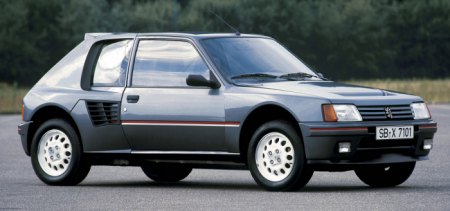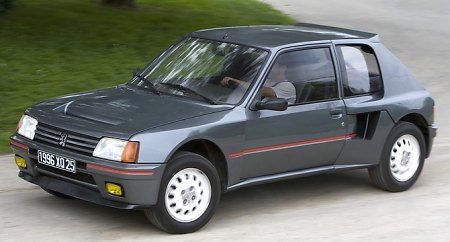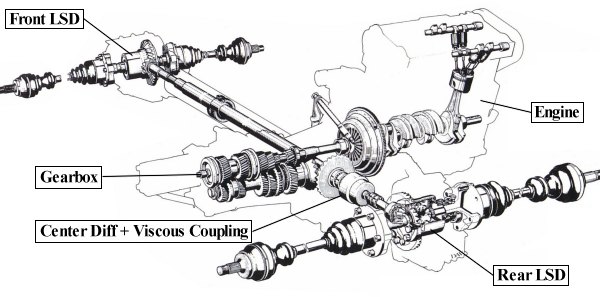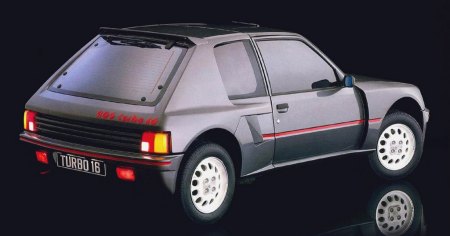 Peugeot 205 T16, or 205
Turbo 16, was the most successful rally car in the shortlived Group B
era. Winning 16 WRC races out of 26 entries, it swept both driver's and
manufacturer's crowns in 1985 and 1986 before the end of Group B.
However, more interesting to us is the 200 units of street car built
for the purpose of homologation. Like the street versions of Audi Sport Quattro, Lancia Delta S4, Ford RS200 and MG Metro 6R4, the
road-going 205 T16 was a by-product of the racing program. It shared
nothing with the mass-production 205 except the windscreen, doors and
headlamps. Mechanically it was completely different, most notably its
mid-engined and 4-wheel-drive layout. The fact that it was shaped and
named to be a 205 member was purely to promote the sales of the mass
production car.
Visually, the T16 can be easily distinguished from lesser 205s by its pronounced wheel arches (which housed wider tracks and tires) and the huge air scoops located behind its doors and rear quarter windows. The latter were used to cool its mid-mounted engine and large air-to-air intercooler. The front half of the chassis, including the passenger cell, was a dedicated steel monocoque, while the rear half was a tubular steel spaceframe structure for mounting the powertrain and suspensions. A large clampshell tailgate integral with rear fenders and quarter windows opened to reveal the whole rear chassis and powertrain for easy servicing, something clearly designed for rallying.  The engine was a twin-cam 16-valve turbo four. It was
deliberately sized to 1775 cc so to be benefited from the lower weight
limit of 2.5-liter class, compared with Audi Sport Quattro's 3.0-liter
class. Quite unusual, the engine and gearbox were mounted transversely,
sitting half-way between the cockpit and the rear axle so to enable an
excellent front-to-rear weight distribution of 45:55. Moreover, the
engine was heavily offset to the right, so that itself and the gearbox
could be located at either side of the longitudinal propeller shaft.
The 4WD system employed FF (Ferguson Formula) Development's patented
epicyclic center differential and viscous coupling to split torque
33:67 front to rear under normal condition, and to lock up the axles in
the presence of significant speed difference. Besides, both front and
rear axles got an ZF limited slip differential.
To offset the weight of the engine, the battery was mounted at the opposite side in the engine compartment. Ditto the intercooler. The fuel tank found space in the cockpit, i.e. right under the seats. This called for the seats to be raised a little compared with the regular car, but it did benefit visibility to the road ahead. Speaking of cockpit, it received an all-new dashboard which was full of gauges. Leather trimmed the dash top and the heavily bolstered bucket seats. Although its build quality looked less rough than most other Group B rally specials, no one would confuse it with a 911 Carrera 3.2 or Ferrari 308 GTB which ridiculously cost roughly the same money at the time! The Peugeot also lacked luggage space to match the usability of these cars, as its front boot was totally occupied by the spare wheel and reinforcement tower bar.  Compared with the regular 205 GTI, the T16 ran a longer wheelbase as its wheels were pushed further to the corners. All-round double-wishbones rode on Bilstein dampers with very long suspension travel. As a result, it actually rode smoother than the GTI on the road. Less surprising was its handling, which was none other than excellent. It cornered fast and flat, with lots of grip and little roll. It turned into corners sharply, exhibiting little understeer. Thanks to superb traction and grip, there was little oversteer to speak of, too. Comparatively, the engine was a let down. With only 200 horsepower available on the street car, its performance was the weakest among its rivals. Peugeot quoted 0-62 (0-100 km/h) in 6 seconds flat, but in reality it felt a second slower. Top speed was limited by its 0.35 Cd to 130 mph. The engine fell short of the level of the chassis. It had obvious turbo lag – below 3000 rpm the turbo ran off-boost, and it took 4000 rpm to feel really brisk, but even then it was still far from explosive – and it begged the driver to keep it at high rev to deliver decent turn of speed. Fortunately, the gearchange was quick and precise and the clutch operated smoothly, so at least the car was fun to be driven hard. Like other Group B specials, the 205 T16 road car was not bought to be used as a daily transport. It was noisy and impractical, and its good ride and handling was offset by the laggy engine. A mid-engined Renault Clio V6 would feel just as special yet much more usable and better built. However, the T16 should have an irreplaceable position in history, thanks to its double WRC titles won at the very peak of rally history.  |